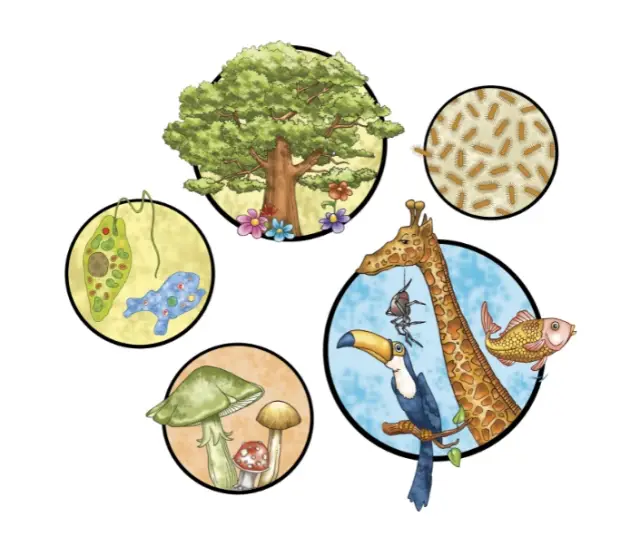Nature is a vast and complex tapestry of life that extends across planet Earth. In its immensity, there are various kingdoms, each with its own richness and uniqueness. These kingdoms represent the main categories in which living beings are grouped according to their fundamental characteristics. From microorganisms invisible to the naked eye to the majestic creatures that dominate landscapes, each kingdom plays a crucial role in the world's ecological balance.
1. Monera Kingdom: Microcosm of Life
The Monera Kingdom encompasses the simplest single-celled organisms: bacteria and cyanobacteria, also known as blue algae. Although tiny, these creatures play a monumental role in terrestrial and aquatic ecosystems. They are responsible for essential processes such as the decomposition of organic matter, nitrogen fixation and oxygen production. Despite their structural simplicity, their adaptability allows them to inhabit a wide range of environments, from the most arid soils to the abyssal depths of the ocean.
2. Kingdom Protista: The Diversity of the Unicellular
The Kingdom Protista is home to a wide variety of single-celled organisms, some of which exhibit characteristics typical of plants, animals or fungi. These include single-celled algae, such as diatoms and euglenas, as well as protozoa, such as paramecium and amoeba. Although they may be tiny, their diversity is astonishing, and their role in ecosystems is crucial. Some are photosynthetic, others are voracious predators, while some are parasites or symbionts.
3. Fungi Kingdom: The Masters of Recycling
Fungi, members of the Kingdom Fungi, are heterotrophic organisms that feed on decaying organic matter. Their role as decomposers is fundamental to the cycle of life, as they break down dead matter and release essential nutrients for other living beings. In addition to their ecological importance, fungi are an invaluable source of food, medicines, and biotechnological tools for humans.
4. Kingdom Plantae: The Producers of Life
The Kingdom Plantae is made up of autotrophic organisms capable of photosynthesis, converting solar energy into chemical energy. From simple mosses to giant trees, plants are the base of the food chain in most terrestrial and aquatic ecosystems. Not only do they provide food and shelter for a wide variety of organisms, but they also play a crucial role in climate regulation and oxygen production.
5. Animalia Kingdom: Diversity in Motion
The vast and diverse Kingdom Animalia is a testament to the adaptability and evolutionary creativity in the natural world. From microscopic organisms to colossal marine mammals, the moving diversity of animals is truly astonishing. This realm encompasses an extraordinary variety of life forms, each uniquely adapted to its environment and lifestyle.
At the heart of this diversity are the different survival strategies that animals have developed over time. Some are agile predators, such as cats and eagles, that hunt with precision and speed. Others, such as grassland or savanna herbivores, have evolved to graze efficiently and detect predators before they get too close. Even within the broadest taxonomic groups, such as insects or mammals, the variety of adaptations and behaviors is surprising.
The shifting diversity of the Animalia Kingdom is also manifested in the animals' ability to occupy a wide range of habitats, from scorching deserts to the abysmal depths of the ocean. Some are specialists, adapted to a specific ecological niche, while others are generalists, able to thrive in a variety of environmental conditions. This adaptive plasticity has allowed animals to colonize virtually every corner of the planet, from the poles to the tropics, from mountain tops to the seabed.
However, beyond their morphological and ecological diversity, animals share a series of fundamental characteristics that distinguish them from other kingdoms of nature. For example, all animals are heterotrophs, meaning they depend on other life forms for energy and nutrients. Additionally, most animals are capable of movement at some point in their life cycle, whether to search for food, escape from predators, or find a mate to reproduce.
6. The Interconnection of Kingdoms
The interconnectedness of nature's kingdoms is a fascinating tapestry of ecological relationships that sustains life on Earth. Although each kingdom has its own distinctive characteristics, they are deeply intertwined in a web of mutual dependence and collaboration. This entanglement manifests itself in various ways, from direct interactions between organisms to large-scale ecological processes that affect the entire planet.
First, symbiotic relationships between different kingdoms are essential for the survival and well-being of many organisms. For example, the symbiosis between plant roots and mycorrhizal fungi is essential for the absorption of nutrients from the soil, benefiting both the plants and the fungi involved. Similarly, symbiotic bacteria that live in the digestive tracts of many animals help them digest food and obtain essential nutrients more efficiently.
Furthermore, biogeochemical cycles, such as the carbon cycle, nitrogen cycle, and water cycle, are key processes involving multiple kingdoms of nature. For example, plants capture atmospheric carbon dioxide during photosynthesis and convert it into organic matter, releasing oxygen as a byproduct. In turn, animals consume plants and release carbon dioxide through respiration, closing the carbon cycle. Likewise, nitrogen-fixing bacteria convert atmospheric nitrogen into plant-usable forms, fueling plant growth and maintaining soil fertility.
In addition to these direct interactions, the kingdoms of nature are also connected through complex food webs that regulate energy and nutrient flows in ecosystems. These food webs describe the feeding relationships between producers, consumers and decomposers in a given ecosystem. For example, in a terrestrial ecosystem, plants serve as primary producers by converting solar energy into food through photosynthesis. Herbivores consume these plants, while carnivores feed on herbivores. Finally, decomposers, such as fungi and bacteria, break down dead organic matter and return nutrients to the soil, closing the nutrient cycle.
